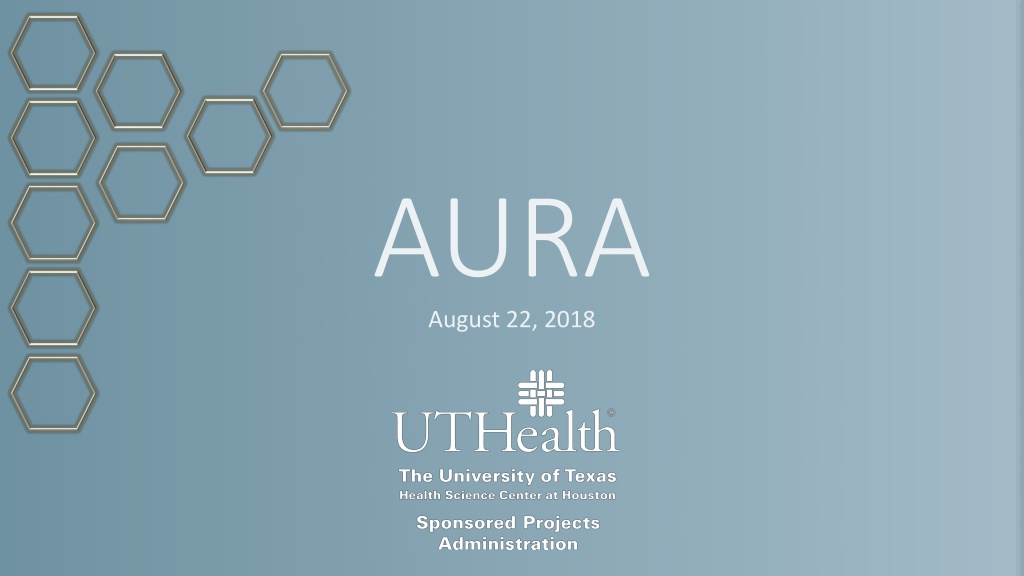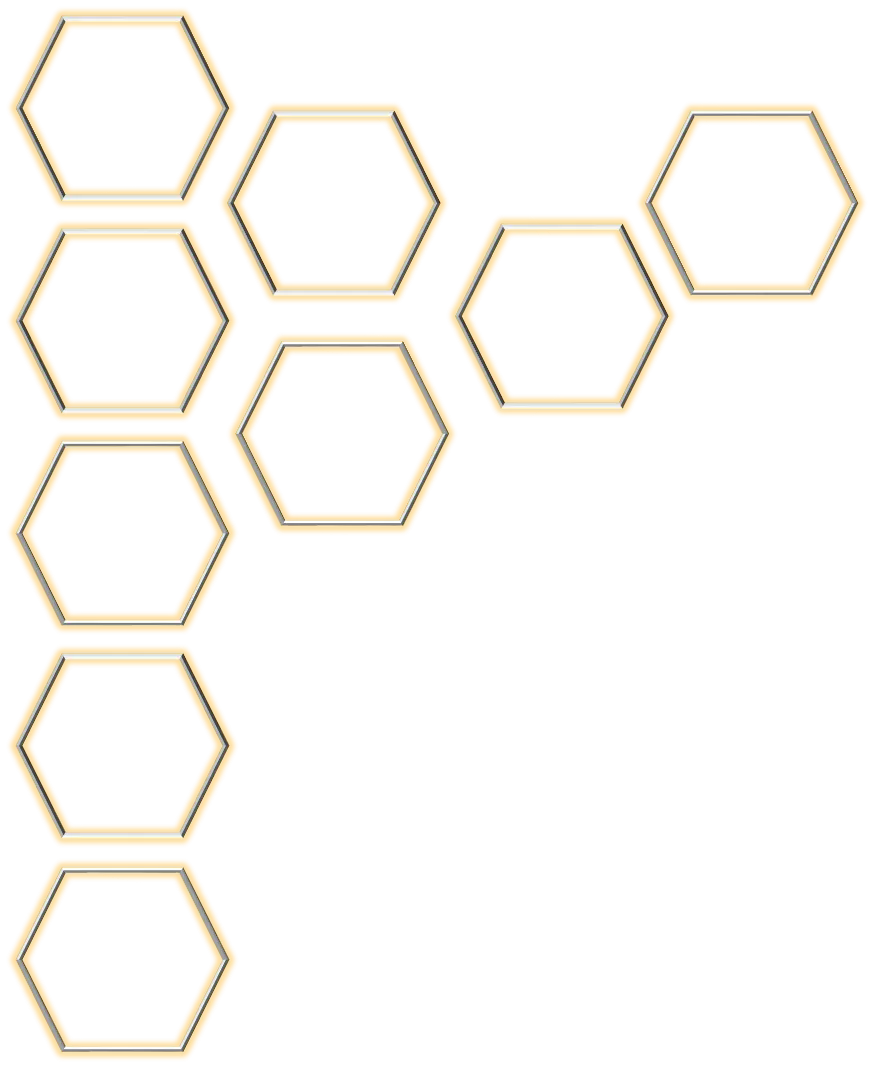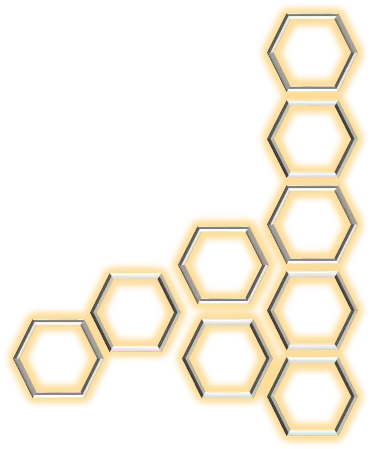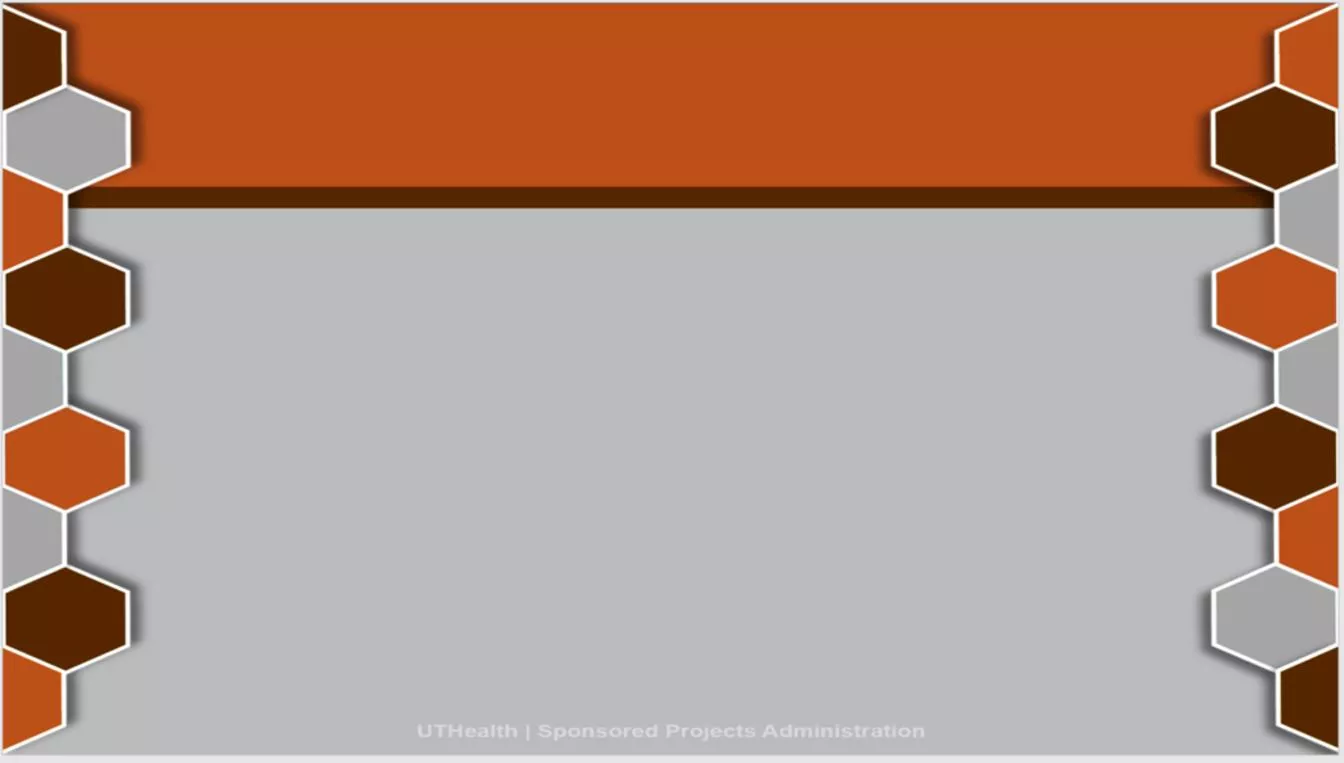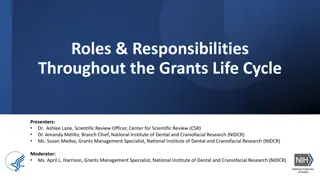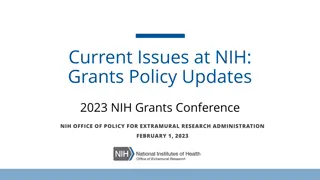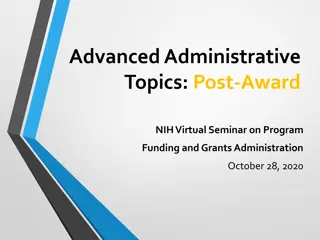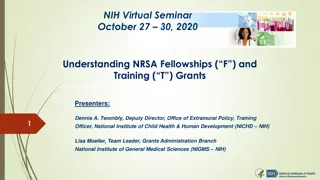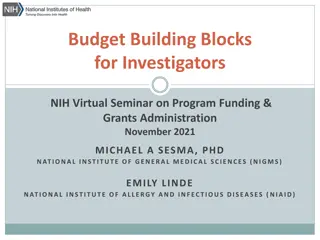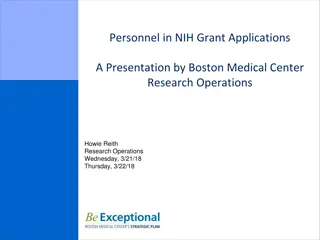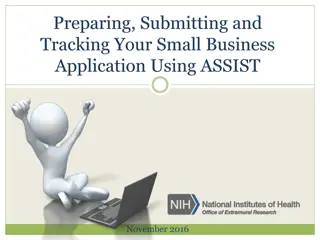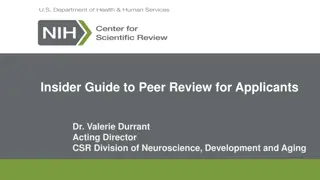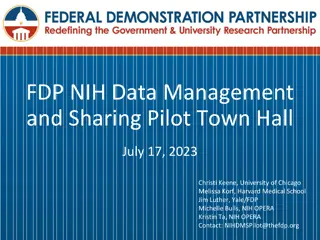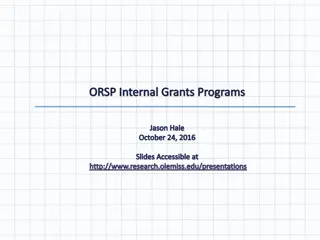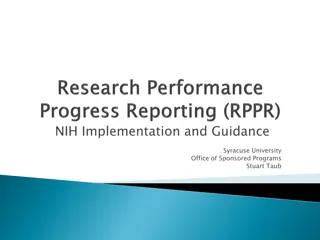Agenda and Requirements for NIH Grants Workshop
This content provides details about the agenda and new requirements for an upcoming NIH grants workshop. Topics include biosketch format, common errors to avoid, new biosketch requirements, contributions to science, research support guidelines, and gathering data for clinical trials. The workshop will cover important areas such as human subjects involvement, NIH attachments, and complete project information forms. Stay informed to enhance your grant application process and avoid common pitfalls.
Uploaded on Mar 06, 2025 | 0 Views
Download Presentation

Please find below an Image/Link to download the presentation.
The content on the website is provided AS IS for your information and personal use only. It may not be sold, licensed, or shared on other websites without obtaining consent from the author.If you encounter any issues during the download, it is possible that the publisher has removed the file from their server.
You are allowed to download the files provided on this website for personal or commercial use, subject to the condition that they are used lawfully. All files are the property of their respective owners.
The content on the website is provided AS IS for your information and personal use only. It may not be sold, licensed, or shared on other websites without obtaining consent from the author.
E N D
Presentation Transcript
AURA August 22, 2018
Agenda 1.Introductions 2.Review of Biosketch Format and Common Errors 3.Review of the NIH Human Subjects Attachment 4.Clinical Trial Account Changes for 9/1/18 5.Preview the new SPA website 6.InfoEd Grants Management System Update
BioSketches Carmen Martinez, Director Grants & Contracts
New Requirements Biosketch format includes 4 major sections: 1. Personal Statement (updated) Include up to four publications and/or research products that highlight experience and qualifications for the project. May include a description of factors e.g. family care responsibilities, illness, disability, active duty military service to explain impediments to past productivity 2. Positions and Honors (unchanged)
New Requirements 3. Contributions to Science (new, required) Up to five contributions to science Up to four references for each contribution Link to a full list of their published work (optional); must have a .gov url 4. Research Support (unchanged) Current and Completed research support only Completed research within 3 years DO NOT list Pending support, % Effort, Direct Costs
Common Errors 1. Too many citations 2. Using links/URLs outside of Bibliography 3. Broken Bibliography link 4. Page Numbers/Footers 5. Including Direct Costs, Effort, and Expired Projects
NIH Human Subjects Attachment Carmen Martinez, Director, Grants & Contracts Audrey Williams, Senior Coordinator, IRB
Gathering Data 1. Complete the Research and Related (R&R) Other Project Information Form to indicate: Whether your project involves Human Subjects If your project is exempt from Federal Regulations 2. Responses are auto-populated onto the PHS Human Subjects and Clinical Trials Information Form
Human Subjects and Clinical Trial Information Form Form is composed of 5 sections: 1. Basic Information 2. Study Population Characteristics 3. Protection & Monitoring Plans 4. Protocol Synopsis 5. Other Attachments
Human Subjects and Clinical Trial Information Form Form is composed of 5 sections: 1. Basic Information 2. Study Population Characteristics 3. Protection & Monitoring Plans 4. Protocol Synopsis 5. Other Attachments
Human Subjects and Clinical Trial Information Form Form is composed of 5 sections: 1. Basic Information 2. Study Population Characteristics 3. Protection & Monitoring Plans 4. Protocol Synopsis 5. Other Attachments * *required for clinical trials
Human Subjects and Clinical Trial Information Form Form is composed of 5 sections: 1. Basic Information 2. Study Population Characteristics 3. Protection & Monitoring Plans 4. Protocol Synopsis (CT only) 5. Other Attachments
Human Subjects and Clinical Trial Information Form Form is composed of 5 sections: 1. Basic Information 2. Study Population Characteristics 3. Protection & Monitoring Plans 4. Protocol Synopsis 5. Other Attachments *only if required by FOA
Clinical Trial Accounting Changes Kathy Kreidler, Assoc. VP, Sponsored Projects
Indirect Costs Current State Indirect costs of 30% are assessed as study expenses post: Revenue Received Salary Expensed: Indirect cost Assessed: $100,000 $ 20,000 $ 6,000 Indirect Funds distributed: 52.5% School $ 3,150 47.5% Central $ 2,850 No IDC on remaining $80,000 until spent.
Indirect Costs Current State As of 6/30/18: 435 open clinical trial accounts $9.7 million fund balance $2.2 million undistributed indirect funds going back to 2002
Indirect Costs Future State Indirect costs of 30% are assessed on revenue received: Revenue Received $100,000 Salary Expensed: Indirect Cost Assessed $ 20,000 $ 6,000 $23,077 Indirect Funds Distributed: 52.5% School $ 3,150 $ 12,115 47.5% Central $ 2,850 $ 10,962
Indirect Costs Future State Departments do not have to wait years to receive indirect costs. Fund balance is a true statement of what the PI has available to spend.
Salary Expense Current State Sponsor paying $10,000 per patient x 10 patients = $100,000 potential revenue: Budgets and effort are based on 100% enrollment. Study Budget (2 years) PI Salary (2%) Coordinator Salary (25%) Non-Salary Expenses Indirects @ 30% Total Expense Residual Balance $ 8,000 $ 30,000 $ 25,000 $ 23,077 $ 86,077 $ 13,923 80% of our studies enroll less than 50%
Salary Expense Current State Study Budget (2 years) PI Salary (2%) Coordinator Salary (25%) $60,000 TOTAL REVENUE RECEIVED $ 8,000 $ 30,000 - Burdensome to department admins - Either don t charge salary at all or, - Move staff around in bulk to wherever the money is. - Misstates effort reports
Salary Expense New process Dept Project CT study team Study Budget (2 years) PI salary (2%) Coordinator Salary (25%) $ 8,000 $ 30,000 SC credit $3,000 SC sal $60,000 RN sal $80,000 Clinical Trial Project $10,000 rev received 10% PI $ 800 10% SC $3,000 IDC $2,308 Dept Faculty Salary PI credit $ 800 PI Sal $200,000 60% of revenue received = 60% of budgeted salary charged.
Salary Expense New Process Dept Project CT study team SC credit $3,000 SC sal $60,000 RN sal $80,000 Credits for salaries charged to studies will post each month based on study revenue is received. True up each half against contract residual accounts $140,000 $ 130,000
Salary Expense New Process Benefits: - Properly assesses salary/fringe expenses to studies - Eliminates effort reporting on industry clinical trials - Eliminates need to move study staff payroll around - Simplifies study close and balance transfer - Quick and easy view of who is fully covered and who is not
Clinical Trial Accounting Changes IDC will be manually recalculated for all revenue received through 8/31/18 First year will involve addressing bumps along the way and maintaining communication. Industry Sponsored Clinical Trials Only Both go into effect 9/1/18
SPA Website Preview Amaris Ogu, Asst. Director, Systems & Reporting
InfoEd Grants Management System Update Kathy Kreidler, Associate VP, Sponsored Projects
InfoEd Global InfoEd Global is the world s leading provider of software to support Electronic Research Administration. 27 year history eRA is all they do Based in Albany, New York Five Modules will be implemented: Proposal Development/SPIN Opportunity Database (S2S with Grants.gov) Proposal Tracking Award Tracking Subawards and Contracts Financial Tracking
InfoEd Global Target go-live is 8/20/2019 Project Team working on: System design via weekly calls with InfoEd Team Organizational Hierarchy Full Communication Plan Drafted (Finalize by 8/31/18) Sneak Peaks Training Plan Being Drafted Reports Reviewing available widgets and wish list of reports Single Sign On Interface (6-8 weeks) Document Storage process and file naming convention
Next Meeting: Nov 14, 2018 THANKS!
